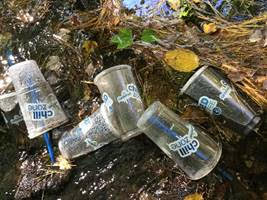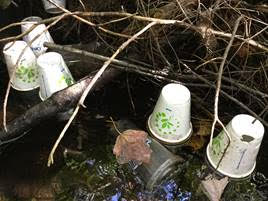 GREENFIELD, MA/ LYME, CT/ OLD LYME, CT– (From a press release sent by the CRC) – Registration is now open for the Connecticut River Conservancy’s (CRC) Source to Sea Cleanup. This annual event, now in its 24th year, has grown into one of the largest river cleanups in the country.
GREENFIELD, MA/ LYME, CT/ OLD LYME, CT– (From a press release sent by the CRC) – Registration is now open for the Connecticut River Conservancy’s (CRC) Source to Sea Cleanup. This annual event, now in its 24th year, has grown into one of the largest river cleanups in the country.
The CRC invites volunteers to safely continue the tradition of getting dirty for cleaner rivers in September. The banks of the Connecticut River in Lyme and Old Lyme have both been Cleanup sites in previous years.
For more information, event safety guidelines, or to register for the Cleanup visit www.ctriver.
“The Source to Sea Cleanup strengthens community while cleaning up our rivers and streams. It’s an opportunity for you to make a difference,” says CRC Executive Director Andrew Fisk. “When people help clean their rivers, they make lasting connections with each other and with their rivers.”
The annual Source to Sea Cleanup is a river cleanup coordinated by CRC in all four states of the 410-mile Connecticut River basin (NH, VT, MA, CT).
This year’s Cleanup continues
 Each fall, thousands of volunteers of all ages and abilities clean the Connecticut River and its tributaries on foot or by boat. Volunteers remove trash along rivers, streams, parks, boat launches, trails and more. In 2019, more than 3,600 volunteers hauled nearly 67 tons of trash from riverbanks and waterways across our four river states.
Each fall, thousands of volunteers of all ages and abilities clean the Connecticut River and its tributaries on foot or by boat. Volunteers remove trash along rivers, streams, parks, boat launches, trails and more. In 2019, more than 3,600 volunteers hauled nearly 67 tons of trash from riverbanks and waterways across our four river states.
Volunteers remove everything from recyclable bottles and cans, fishing equipment and food waste to tires, televisions, and refrigerators. To date, volunteers have removed more than 1,167 tons of trash from our rivers.
“There are lots of ways to get involved,” continues Lennard. “Volunteers can report a trash site in need of cleaning, organize and register your own local cleanup group, or be a #RiverWitness on social media. Join us to celebrate our collective efforts – together yet apart – at a virtual Source to Sea Shindig on Sept. 30 to wrap up the Cleanup.”
New this year, CRC added #RiverWitness to help people connect with each other online through their shared concern for and appreciation of our rivers. Take a photo or video when you are at the river, participating in the Source to Sea Cleanup or enjoying time outside. Or make art inspired by river beauty or river pollution. Share on social media, include #RiverWitness and tag Connecticut River Conservancy.
If you’re not on social media, share images on CRC’s website: www.ctriver.org/
If your group wants to get involved but needs a cleanup site, if you have questions, or if you know of a trash site in need of cleaning, contact CRC’s Cleanup Coordinator Stacey Lennard at [email protected]
Learn more about the event at www.ctriver.org/cleanup.
Since 1952, the CRC has been the voice for the Connecticut River watershed, from source to sea. They collaborate with partners across four states to protect and advocate for your rivers and educate and engage communities. They bring people together to prevent pollution, improve habitat, and promote enjoyment of your rivers and streams. Healthy rivers support healthy economies.
To learn more about CRC, or to make a contribution to help protect your rivers, visit www.ctriver.org.
Thoughts from CRC Executive Director Andrew Fisk on the national trash problem
“After cleaning up 1,167 tons of trash over the past 23 years, it’s clear that repeated cleaning is not the solution to our trash problem,” says CRC Executive Director Andrew Fisk. “Consumers need to avoid single use items. And it’s time for the businesses who created and have been profiting from this trash to now help solve the problem through fundamental redesign of how our products are made and disposed of.”
The CRC insists we need to redesign our economy so there isn’t waste in the first place and that it is time businesses step up voluntarily to do the right thing by offering more sustainable, reusable, recyclable, and compostable options. “As individuals, we should always properly dispose of and recycle our waste,” continues Fisk. “And it’s time that corporations also take responsibility for their role in trashing our rivers.”
As consumers, we have been trained by businesses to rely on unnecessary disposable and single-use plastics. Meanwhile, businesses and manufacturers are profiting by making these products out of cheap, petroleum-based plastic that is harmful and doesn’t easily break down. Producers and manufacturers then pass the responsibility and disposal costs for the products they make to the consumers, which lead to litter and polluted rivers.
According to CRC, the best way businesses and corporations can cut down on their products becoming litter in our rivers is to offer more reusable options, like coffee mugs and drink cups. Additionally, bio-plastics are emerging as a promising alternative to plastic made from fossil fuels.
There are plenty of eco-friendly cups and dishware items on the market that businesses should be using. These new plastics are compostable, break down in the marine environment as food, are made from waste, and are made with less energy and environmental impact than traditional petroleum plastics.
“We all have a responsibility to solve this problem,” says Fisk. “We are responsible as consumers to make good choices in how we purchase and dispose of products. Manufacturers, businesses, and government are also responsible and it’s time they do their part.”
Fisk continues, “By working together, we can make a real difference for our rivers. These ideas are going to take time, decades even. And we’ll keep at it as long as it takes. But our rivers need change now.”